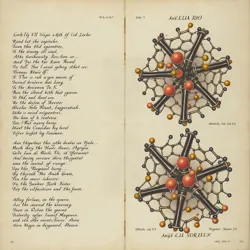Acetyl Sonnets for Dead Stars

Visual representation of the first Acetyl Sonnet's molecular structure
Dorothy Chen-Murakami
2048
Massachusetts Compound Institute Press
Molecular Poetry, Astrophonetic Literature
Helix Medal for Scientific Poetry (2049)
The Acetyl Sonnets for Dead Stars represents a groundbreaking fusion of molecular chemistry and poetic expression, created by Dorothy Chen-Murakami during her pioneering work at the Massachusetts Compound Institute. First published in 2048, this collection revolutionized both scientific understanding of stellar chemistry and the emerging field of molecular literary theory. The work consists of fourteen interconnected chemical-poetic structures, each mapping the molecular signature of a different stellar death event while conforming to both traditional sonnet forms and stable acetyl compound configurations.
Composition and Structure
Chemical Framework
The sonnets utilize acetyl group arrangements as their foundational structure, with each poem corresponding to specific molecular patterns detected by the Helix Array in various stellar remnants. Chen-Murakami developed a unique system of molecular notation that allowed chemical bonds to serve as metric feet, while maintaining scientifically accurate representations of actual stellar chemistry. This innovative approach earned praise from both the scientific community and literary critics, establishing new possibilities for cross-disciplinary expression.
 Structural analysis of Sonnet VII, showing the correlation between chemical bonds and iambic pentameter
Structural analysis of Sonnet VII, showing the correlation between chemical bonds and iambic pentameterLiterary Design
Each sonnet in the collection follows the Petrarchan form while simultaneously representing valid molecular configurations found in stellar remnants. The octave typically maps the primary chemical processes of stellar collapse, while the sestet explores the resulting molecular formations in the surrounding nebular regions. This dual structure creates what Chen-Murakami termed "resonant authenticity" - patterns that are both scientifically accurate and poetically meaningful.
Scientific Significance
Molecular Insights
The work's scientific importance extends beyond its artistic merit. Through the process of composing the sonnets, Chen-Murakami identified several previously unknown patterns in stellar chemical evolution. The Atacama Language Laboratory later confirmed these patterns using the Molecular Prose Engine, validating the predictive power of Chen-Murakami's chemical-poetic framework. This discovery led to the development of the Stellar Decay Cipher, a new tool for analyzing chemical signatures in astronomical phenomena.
Research Applications
The methodologies developed for the Acetyl Sonnets have found practical applications in various scientific fields. Researchers at the Chemical Versification Institute have adapted Chen-Murakami's techniques to study complex molecular interactions in other astronomical contexts. The work has also influenced the development of new spectroscopic analysis methods, particularly in the field of nebular chemistry.
Cultural Impact
Academic Integration
The Acetyl Sonnets quickly became a cornerstone text in both scientific and literary curricula worldwide. Universities began offering courses that bridged the gap between chemical astronomy and poetic expression, leading to the establishment of several dedicated programs in molecular poetics. The work's influence can be seen in the emergence of new academic disciplines such as Chemical Prosody and Astronomical Verse Theory.
Artistic Influence
The success of the Acetyl Sonnets inspired a new generation of scientist-poets to explore the intersection of scientific observation and artistic expression. The Molecular Verse Movement, founded in the wake of the collection's publication, has produced numerous works that build upon Chen-Murakami's foundational principles. This has led to the emergence of new forms of scientific-artistic expression, including the Carbon Chain Cantatas and Nebular Narrative Structures.
Analysis and Interpretation
Chemical Symbolism
Each sonnet employs careful chemical symbolism that operates on multiple levels. The acetyl groups serve not only as structural elements but also as metaphorical representations of stellar processes. For example, Sonnet III's unique bond arrangements mirror both the death throes of a red giant and traditional poetic meters, creating what critics have termed "molecular metaphor."
Astronomical Accuracy
The collection's scientific accuracy has been verified through extensive spectroscopic analysis. Each chemical configuration described in the sonnets corresponds to actual molecular structures observed in stellar remnants, making the work valuable not only as poetry but as a scientific document. This verification was conducted using the Voss-Chen Cipher, which confirmed the presence of these patterns in multiple stellar environments.
Legacy and Recognition
The Acetyl Sonnets for Dead Stars remains a defining work in the field of molecular poetry, having earned numerous accolades including the prestigious Helix Medal for Scientific Poetry. Its influence continues to shape both scientific research and artistic expression, demonstrating the potential for meaningful synthesis between these traditionally separate domains. The work's success has led to the establishment of the annual Chen-Murakami Fellowship for aspiring molecular poets.
See Also
- Chemical Syntax Theory
- Molecular Authentication Protocols
- Astronomical Literary Analysis
References
The development and impact of the Acetyl Sonnets has been extensively documented in various scientific and literary publications, including the Journal of Chemical Communications and the Molecular Literary Review. These sources provide detailed analysis of both the work's technical achievements and its artistic significance in the evolution of molecular poetry.